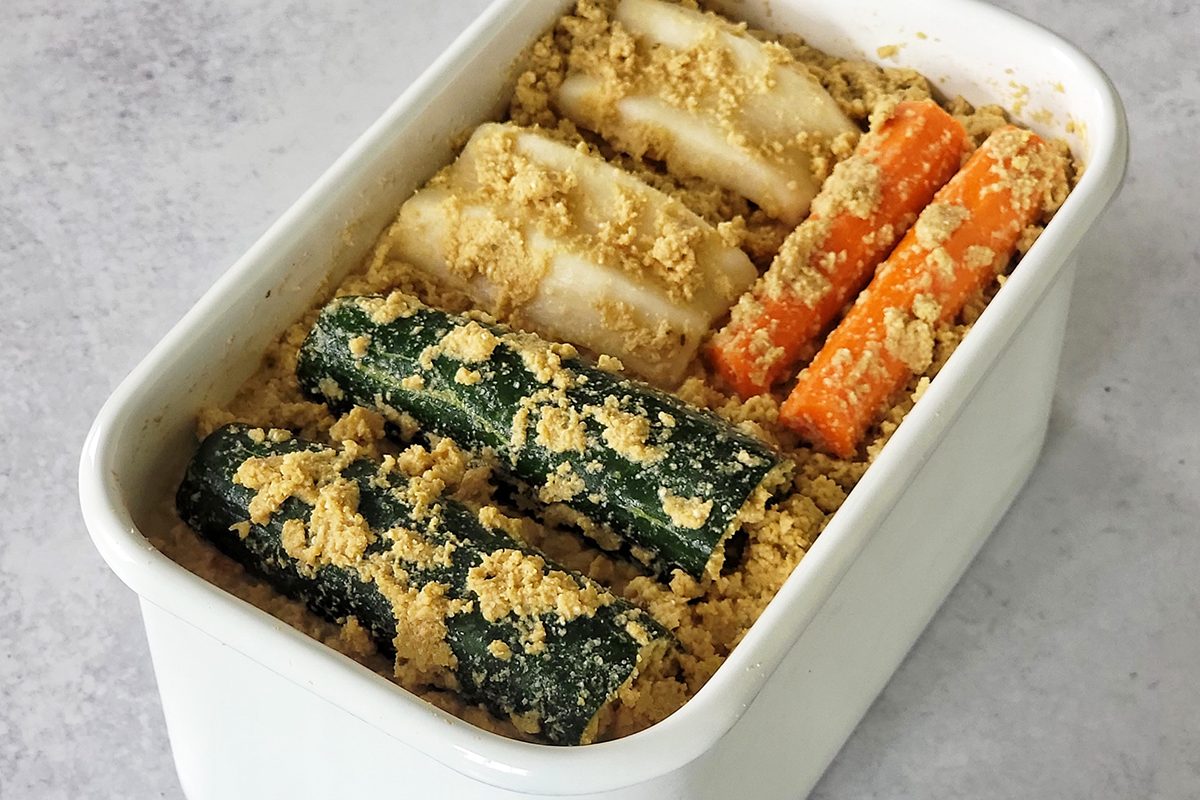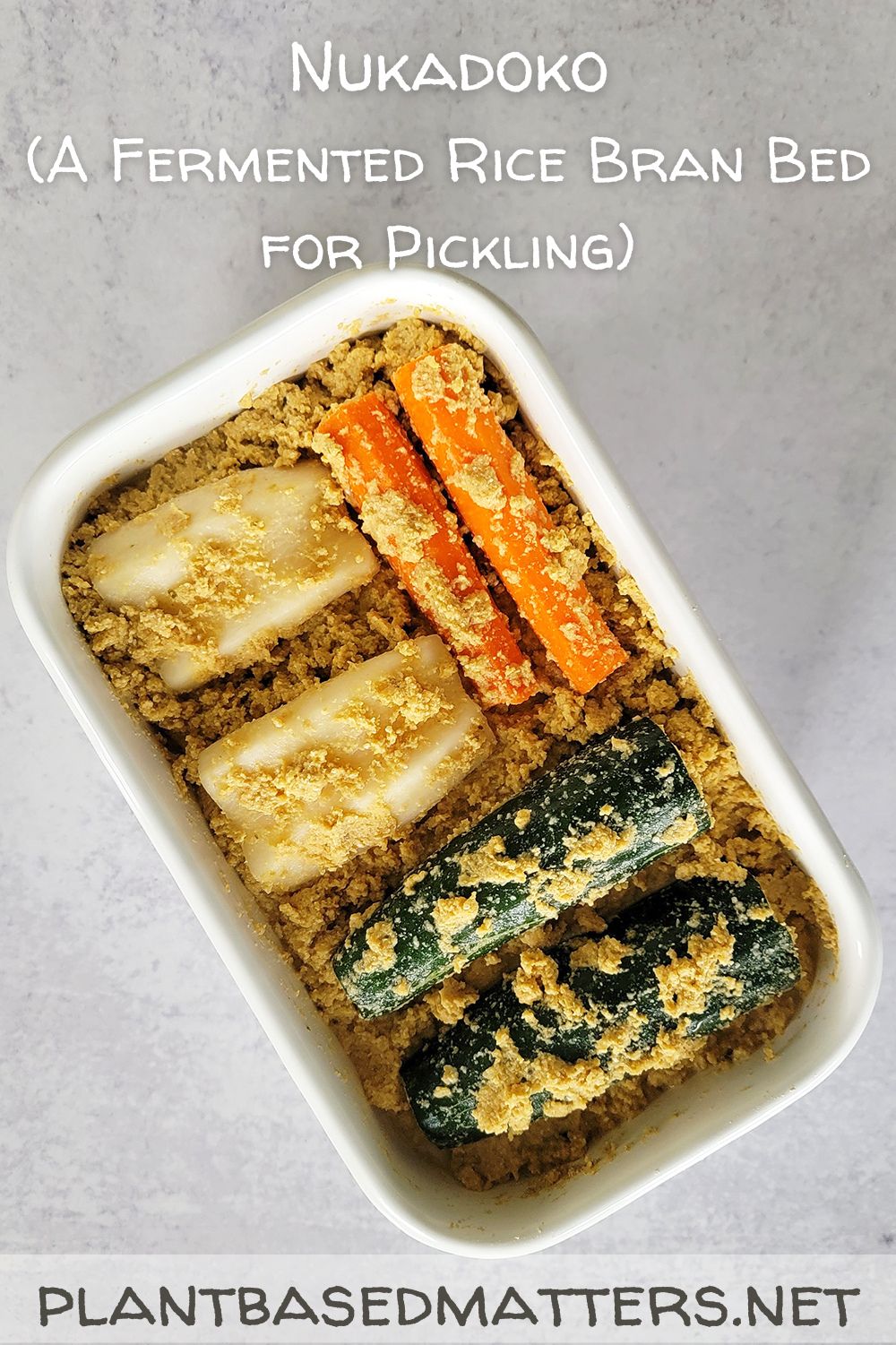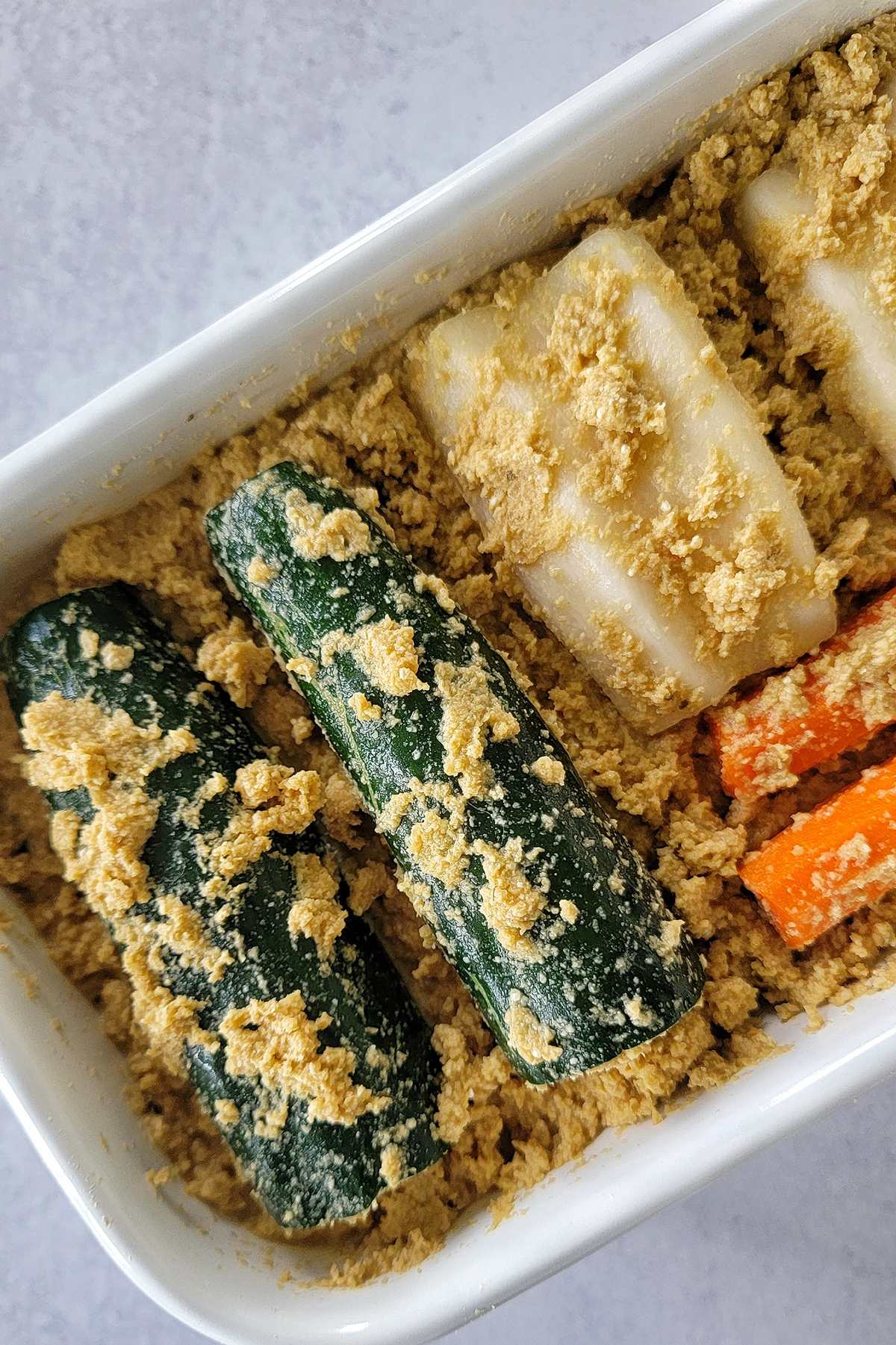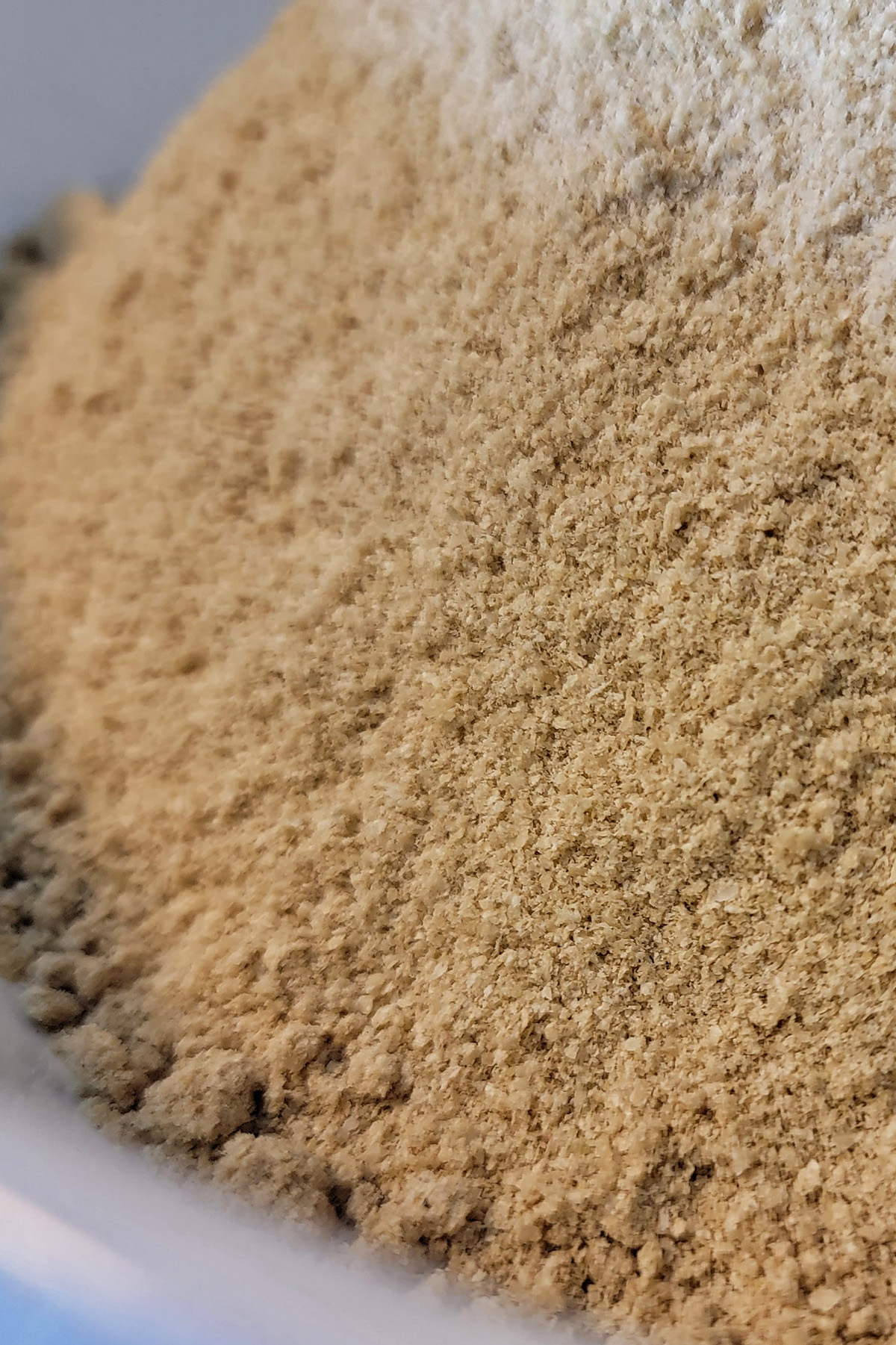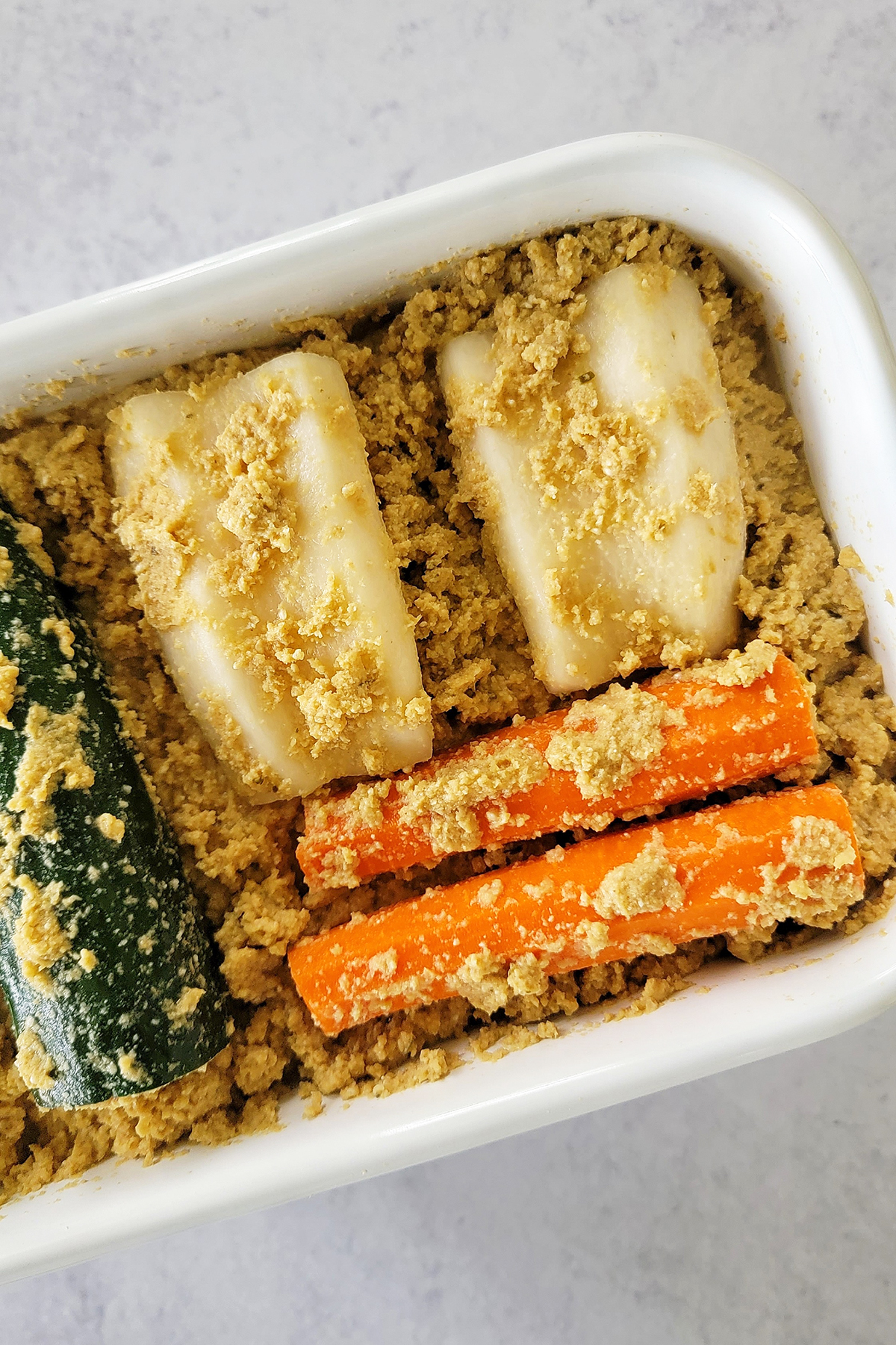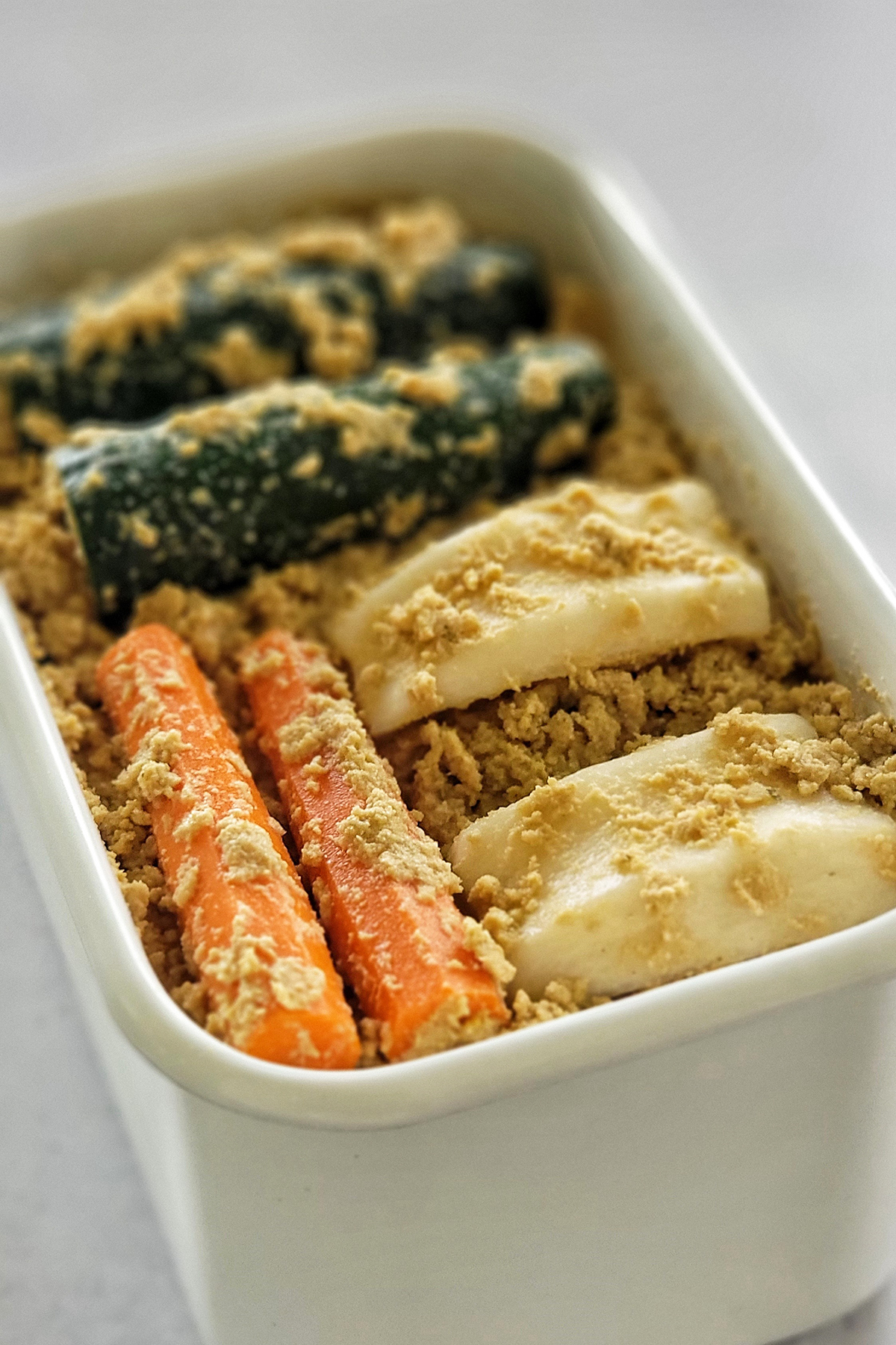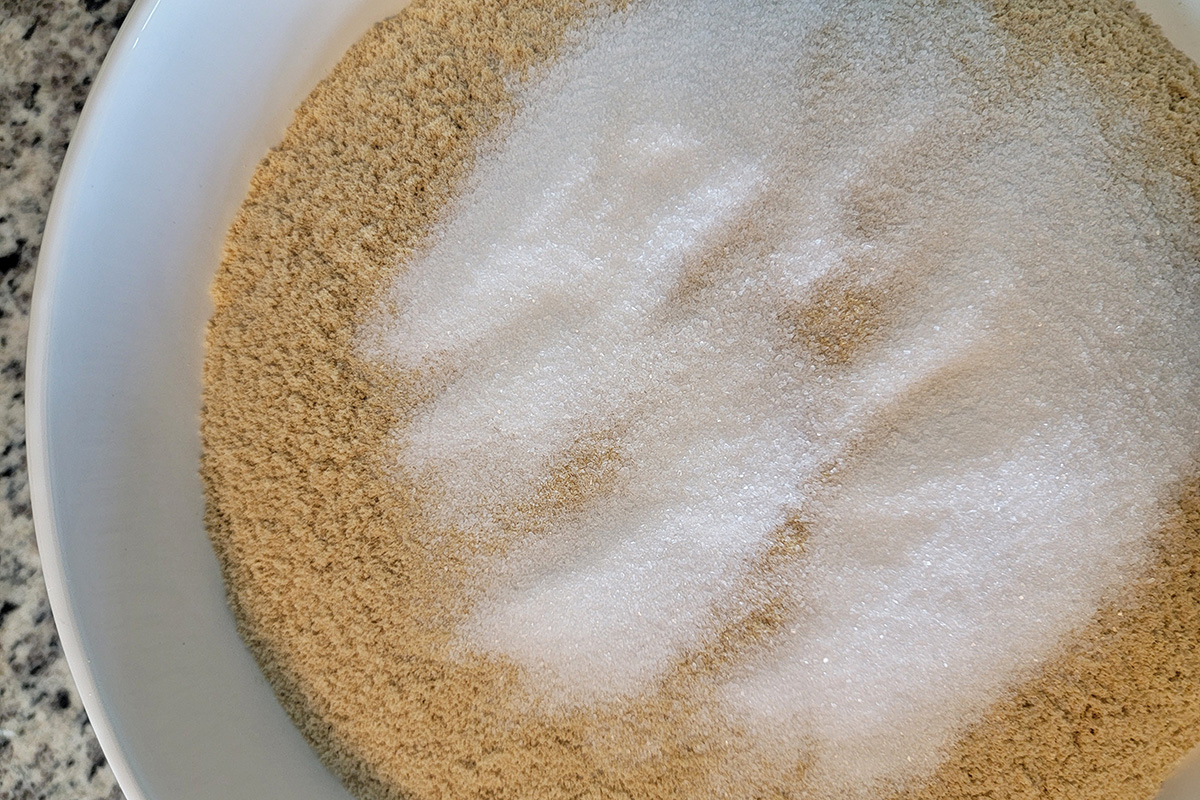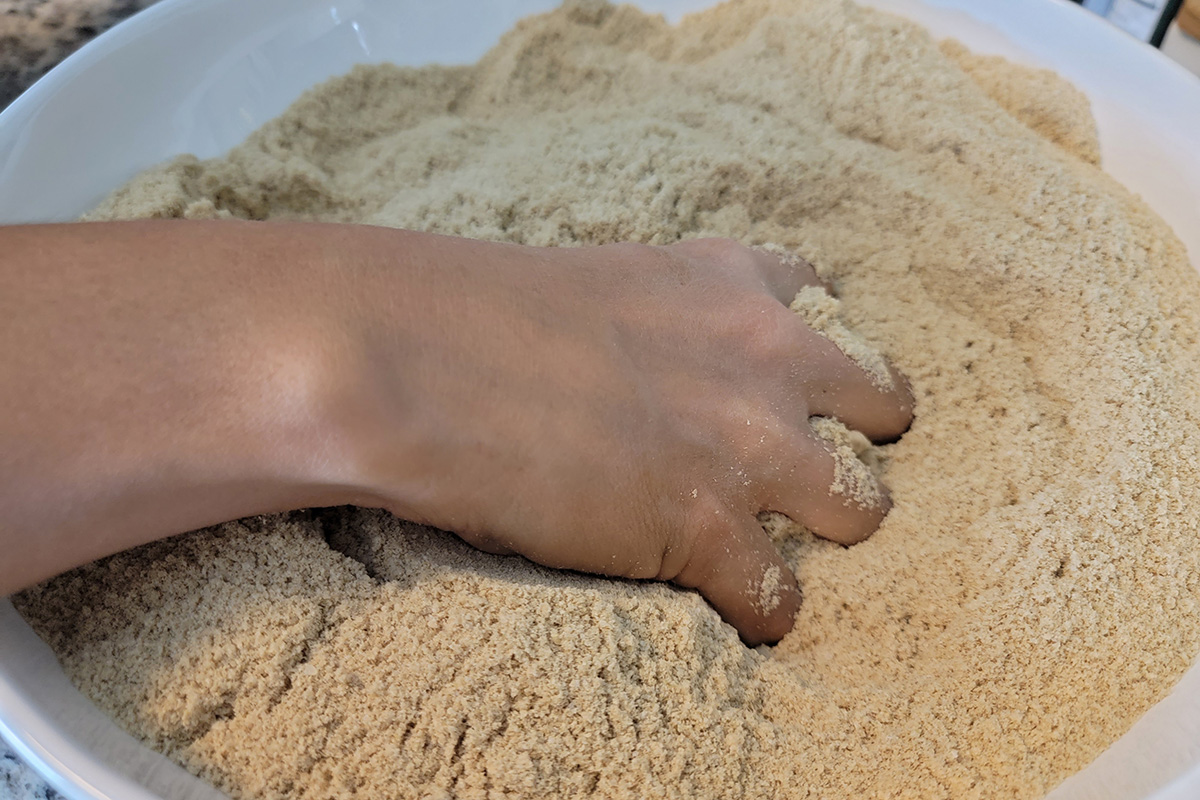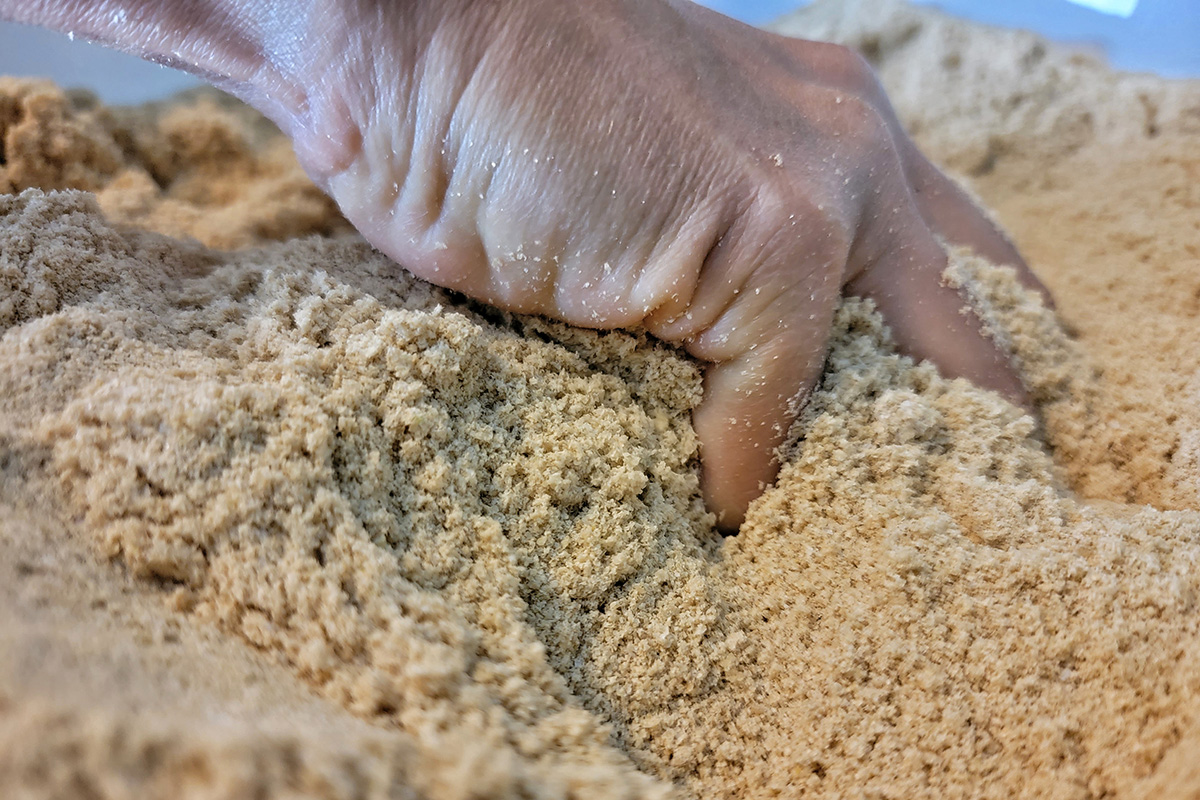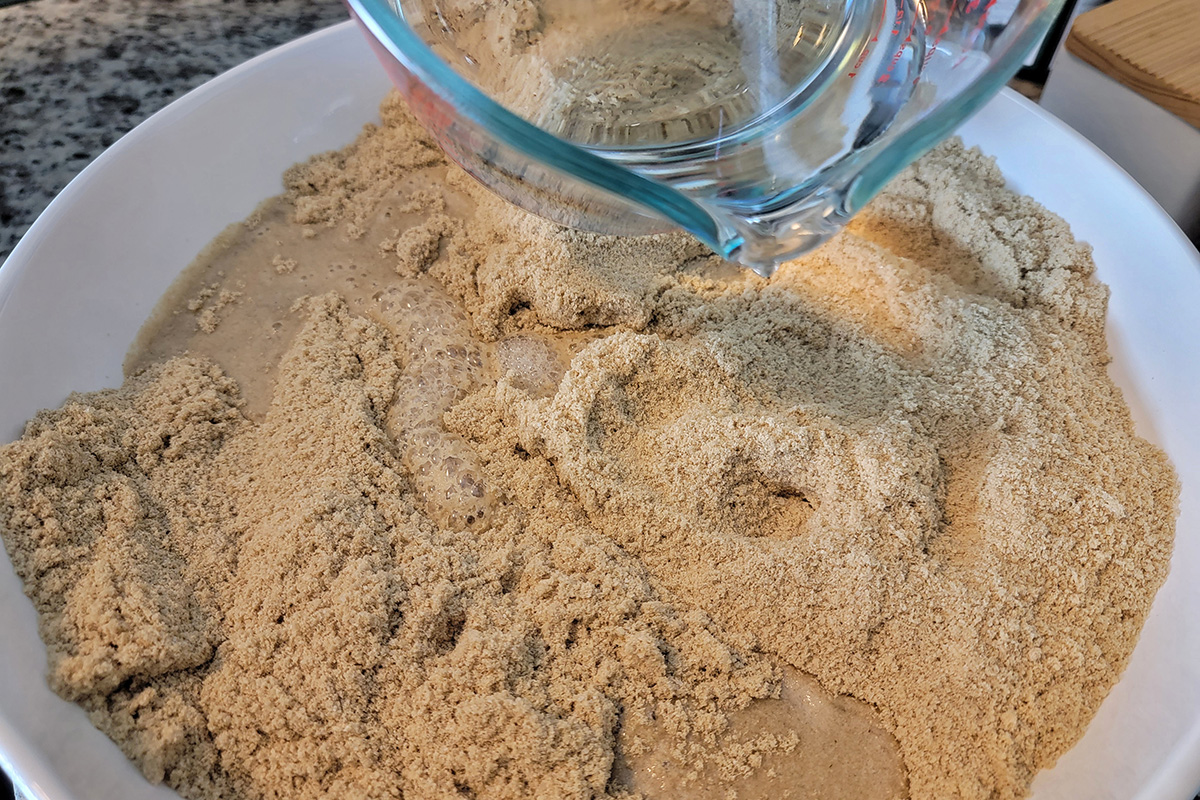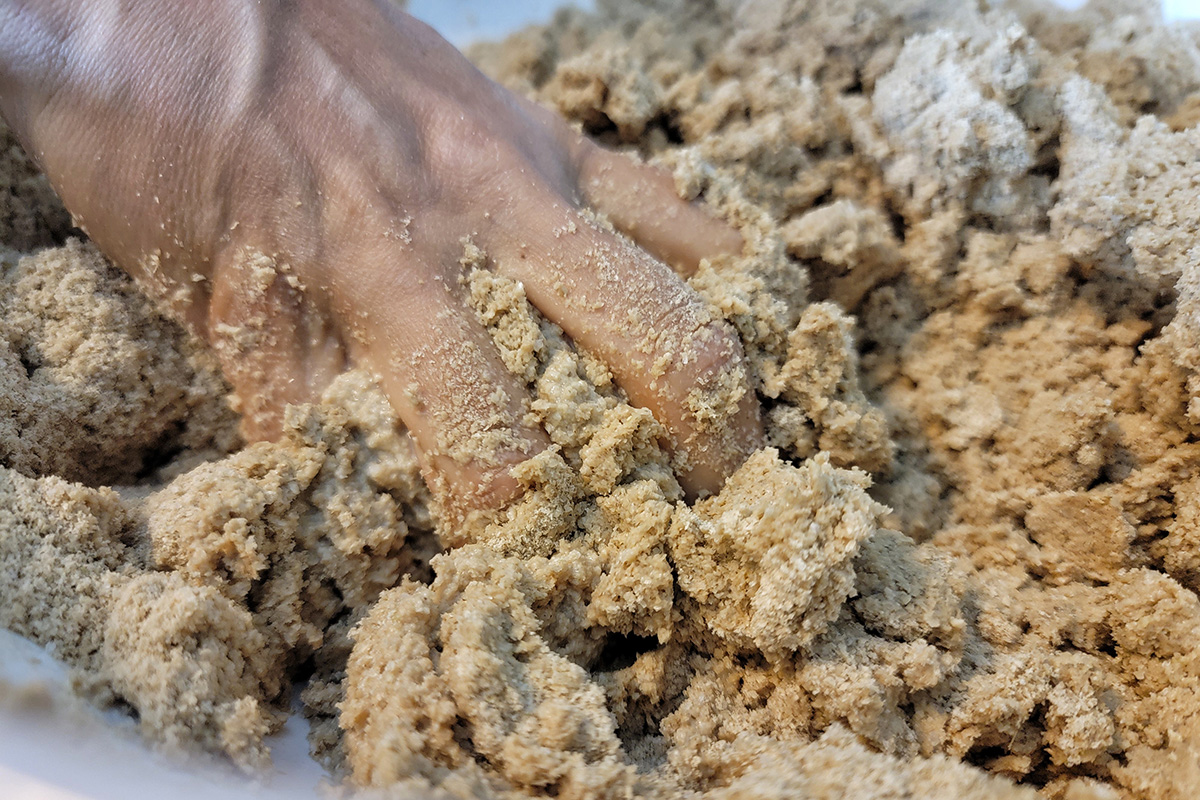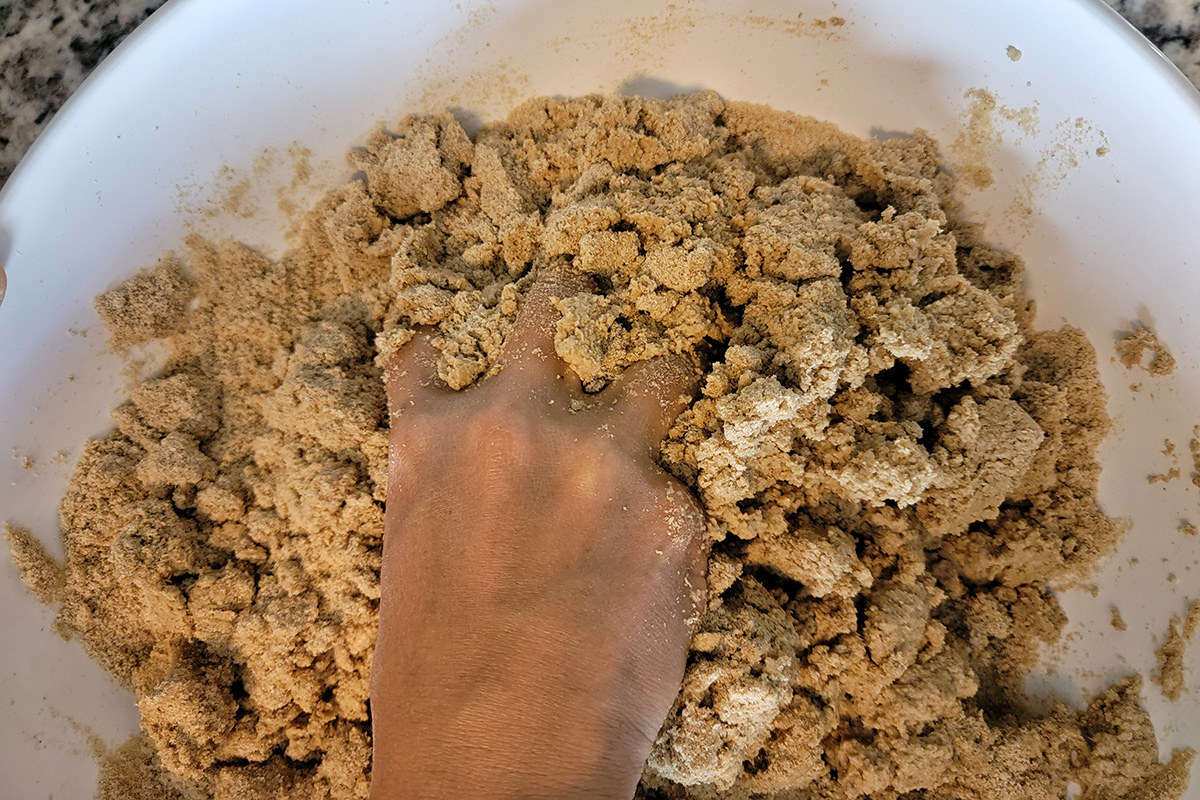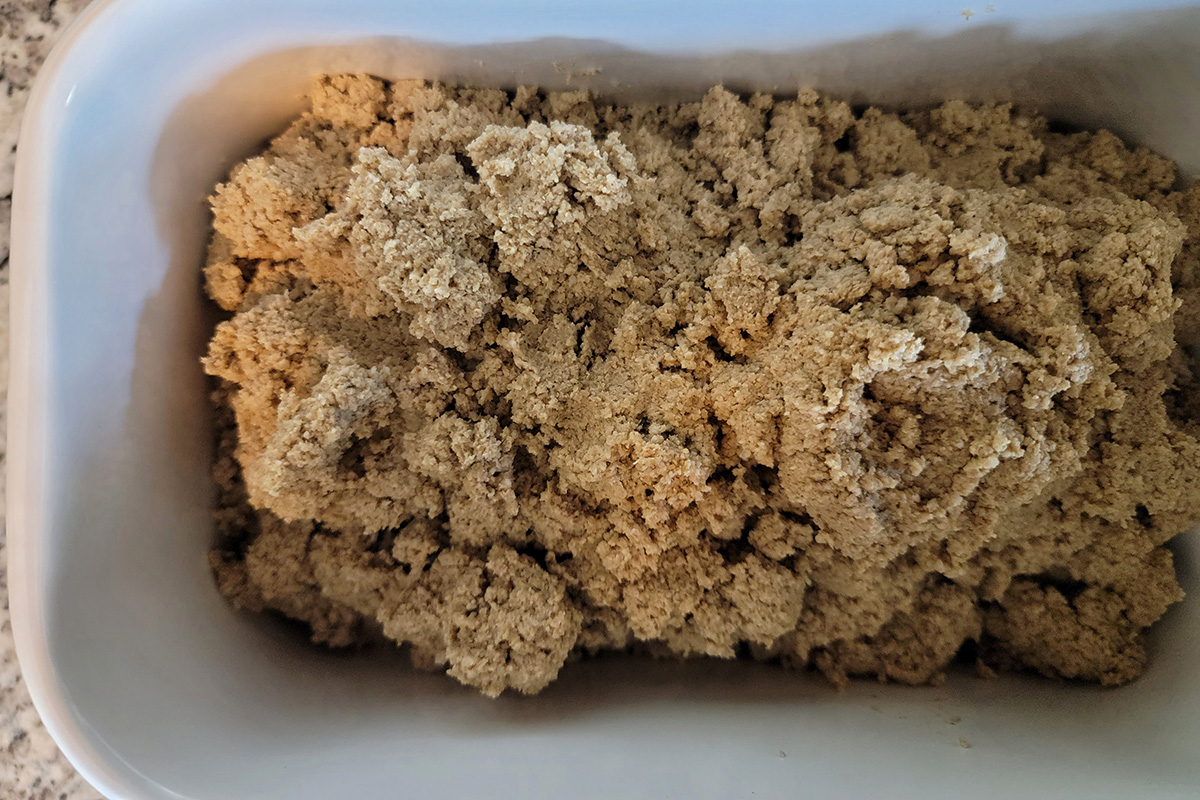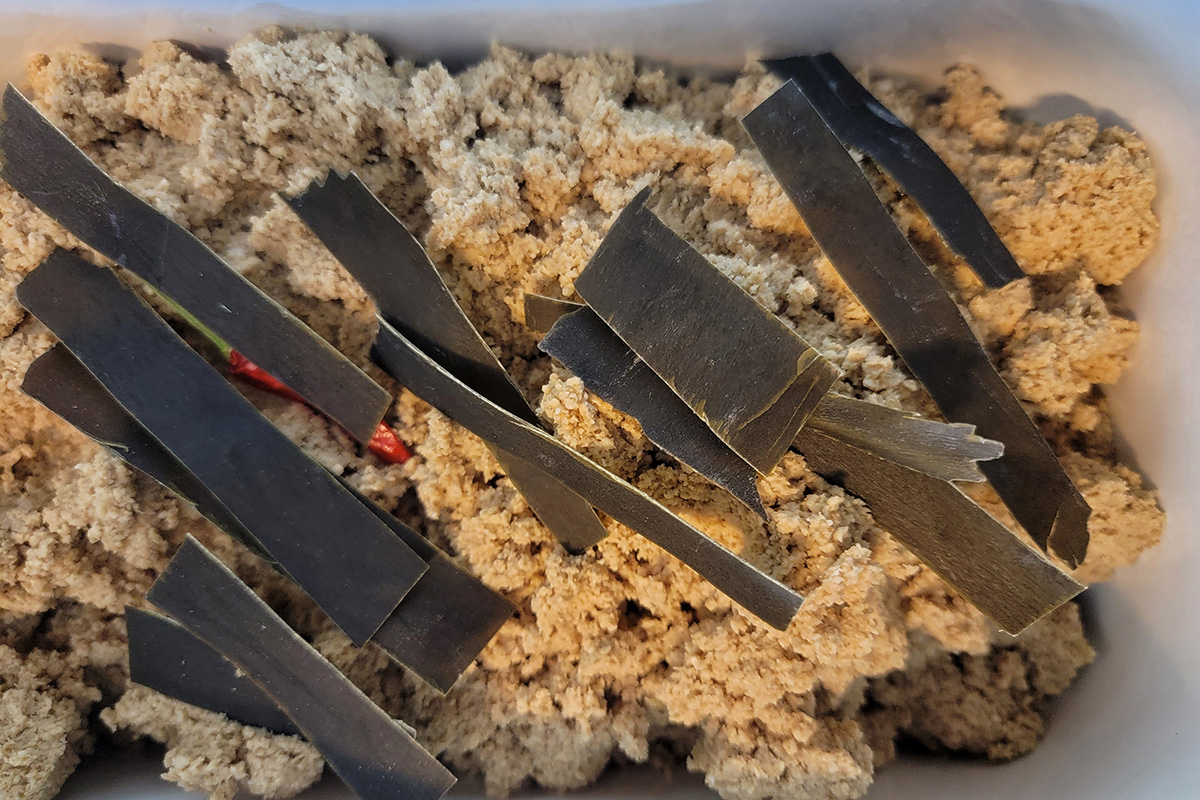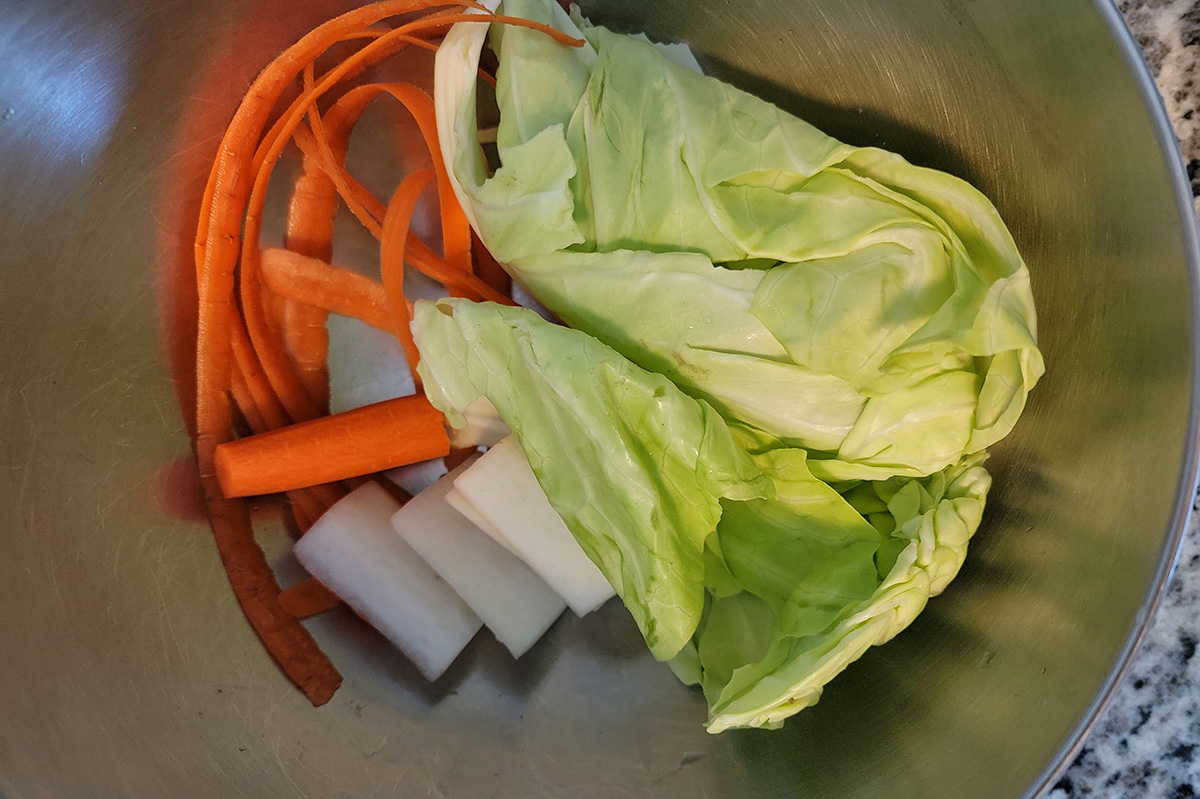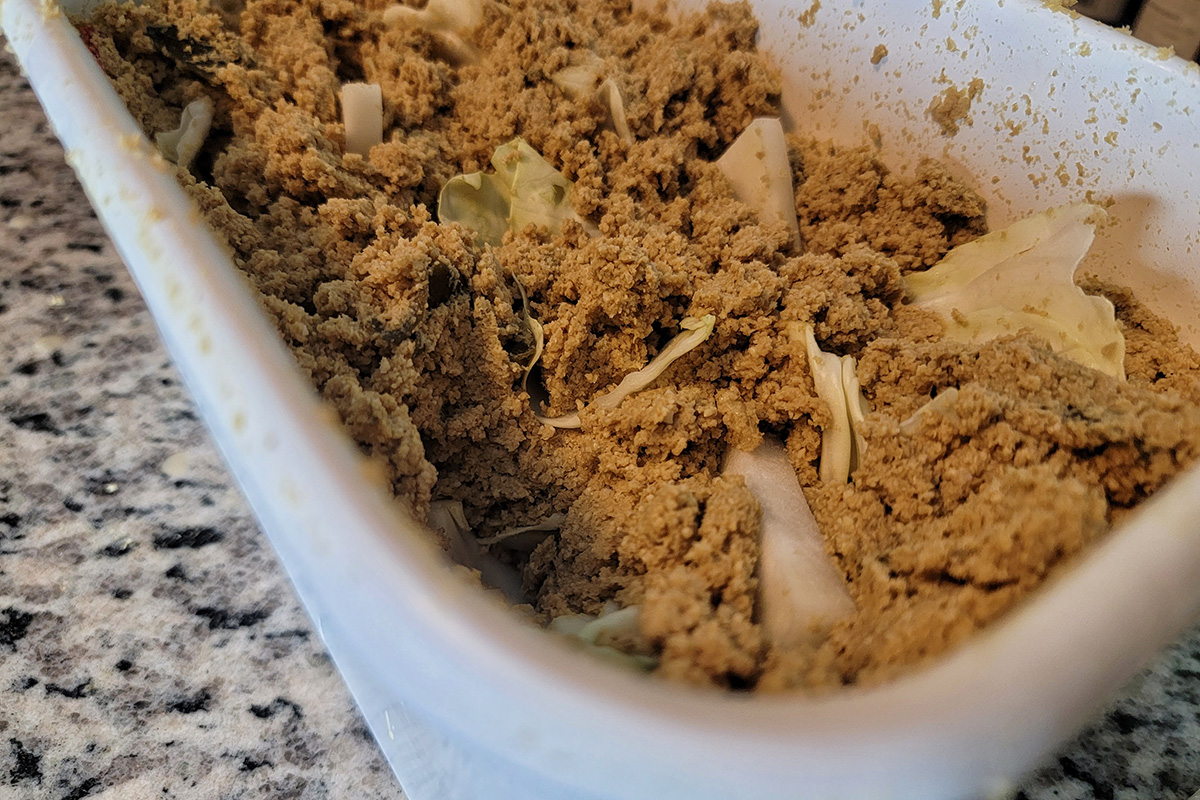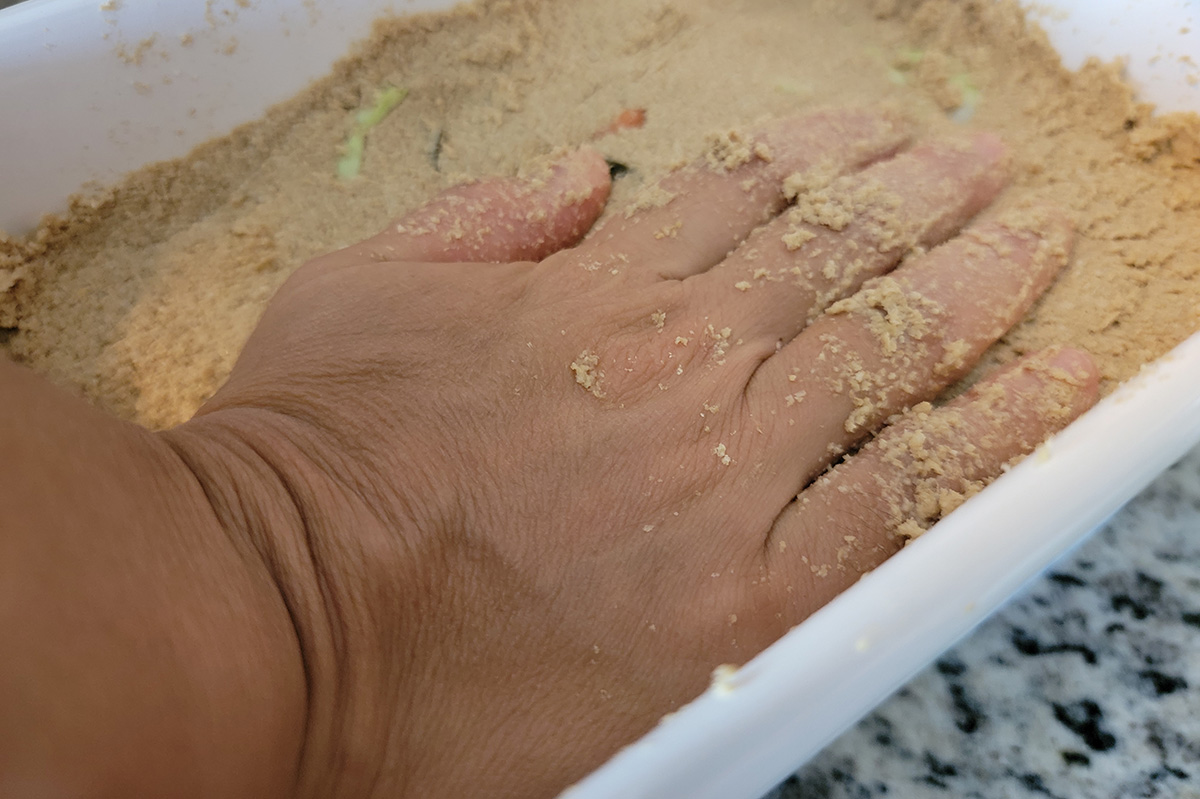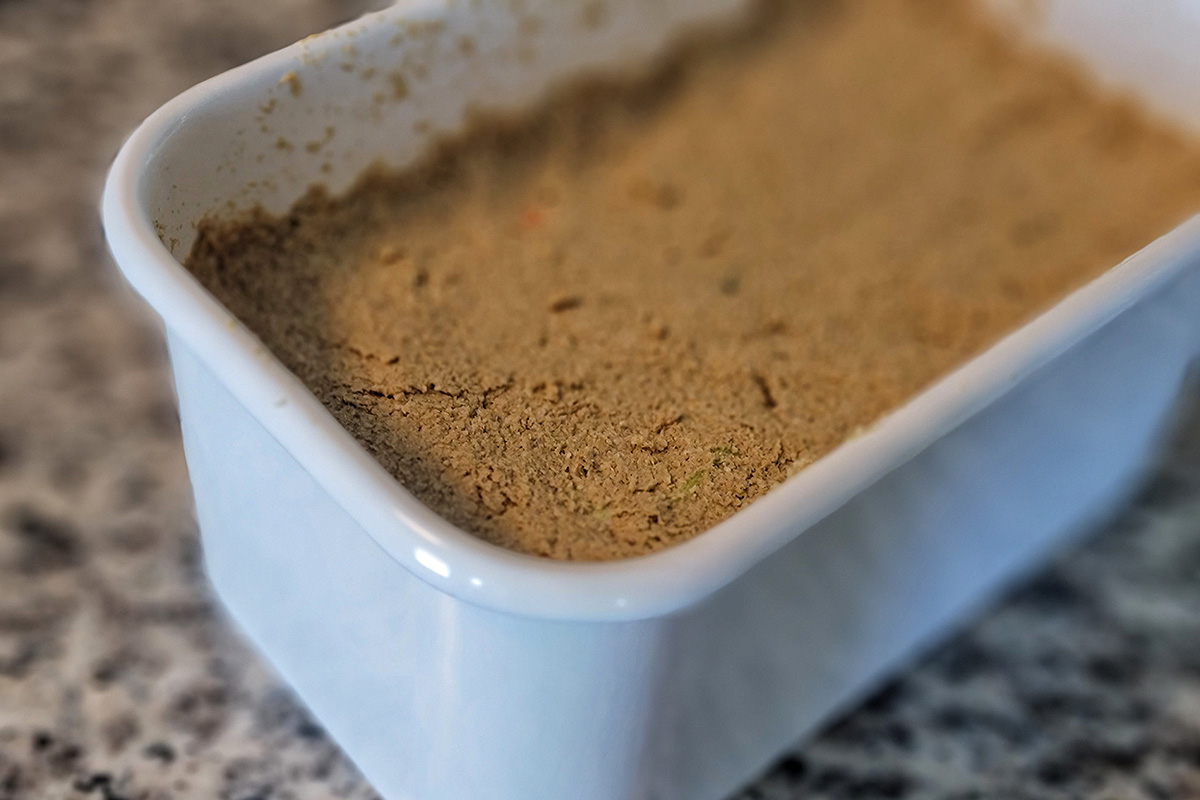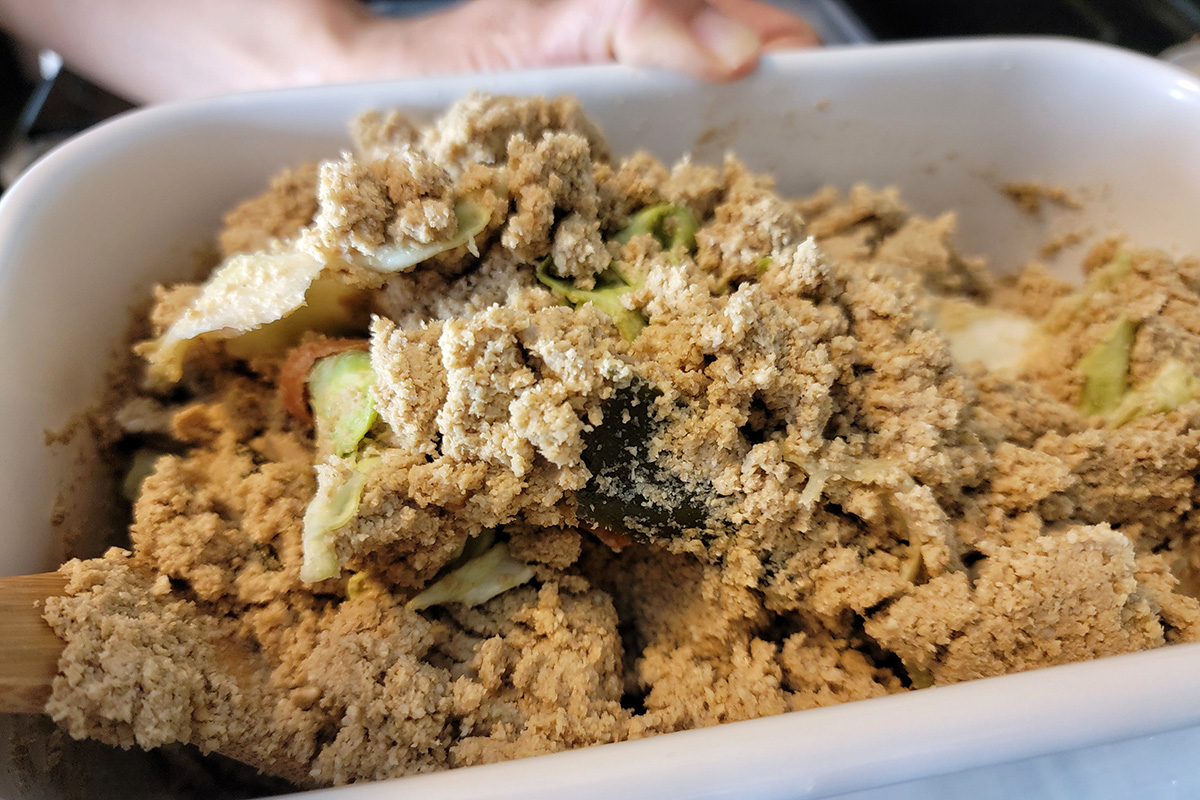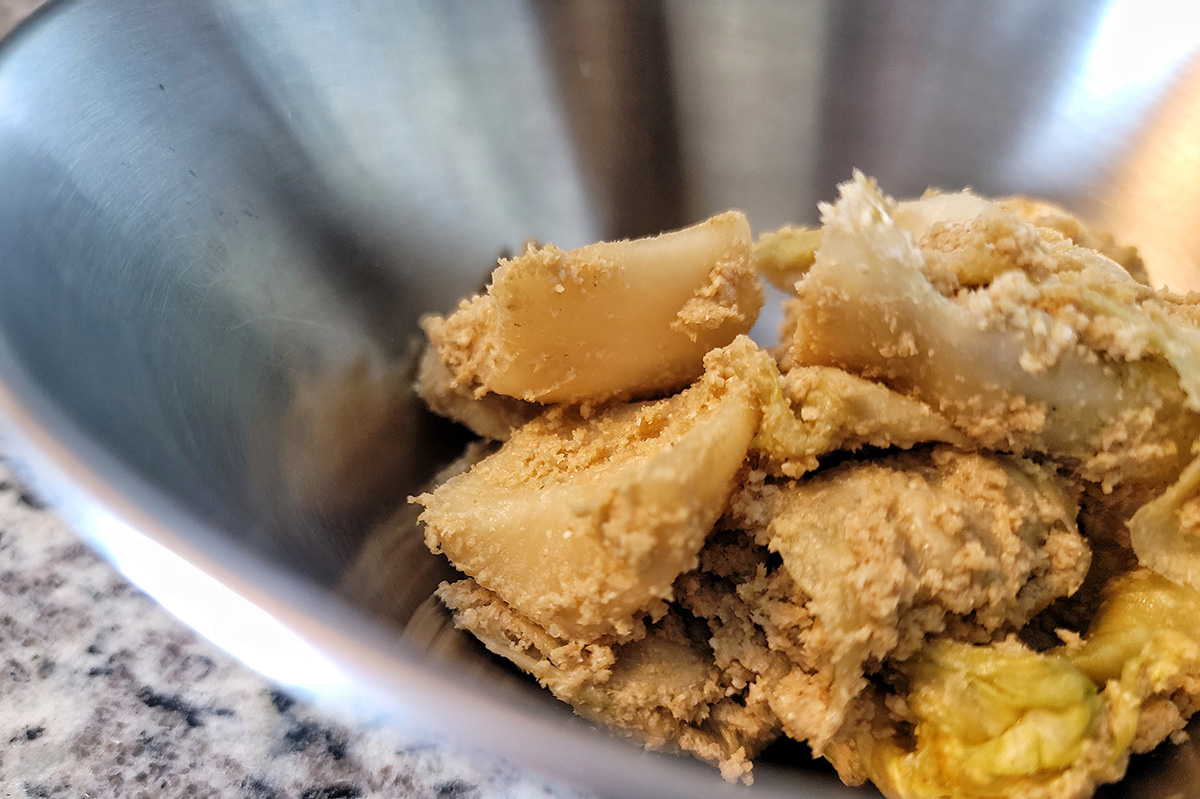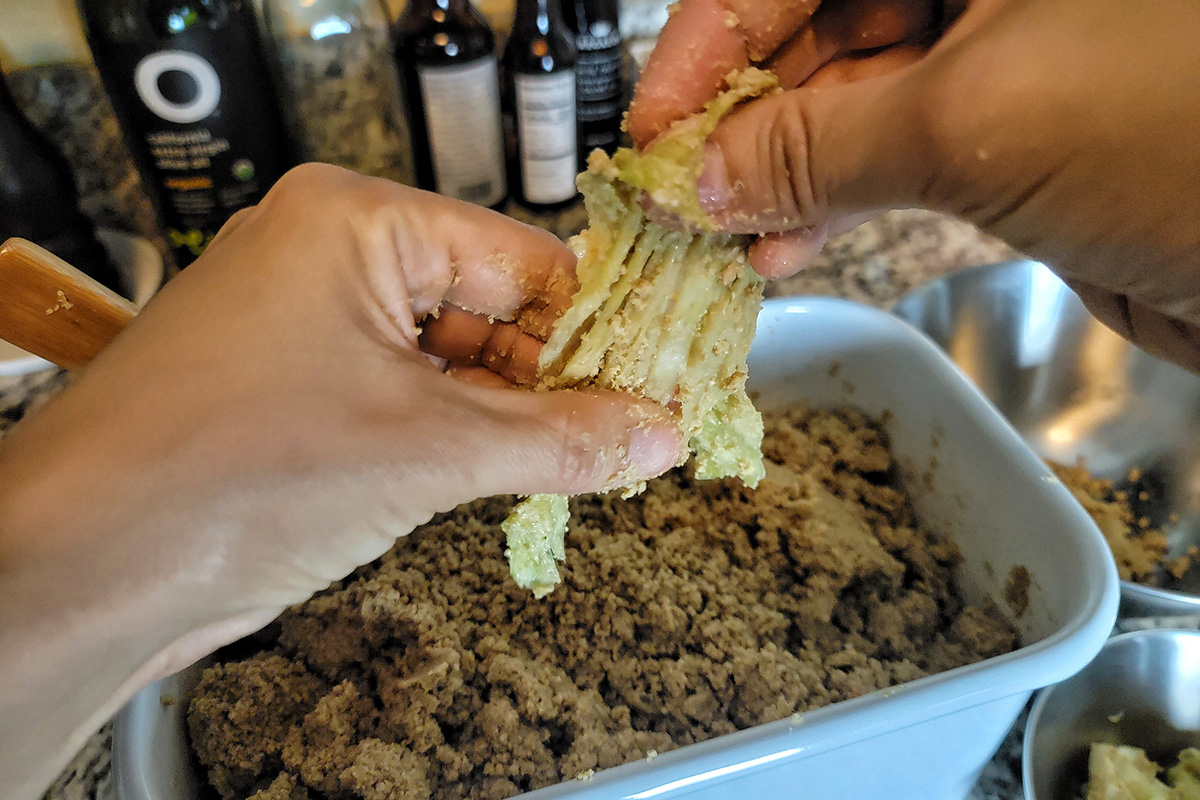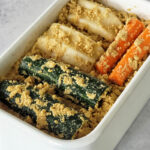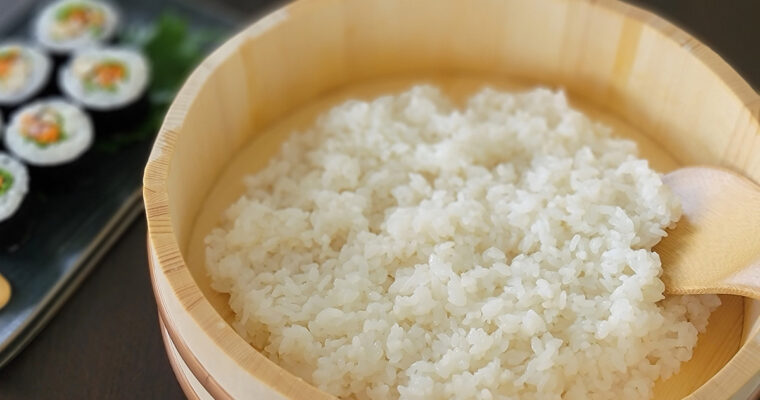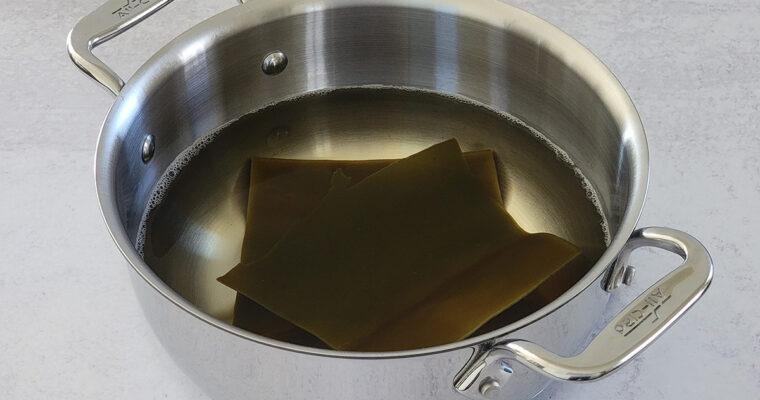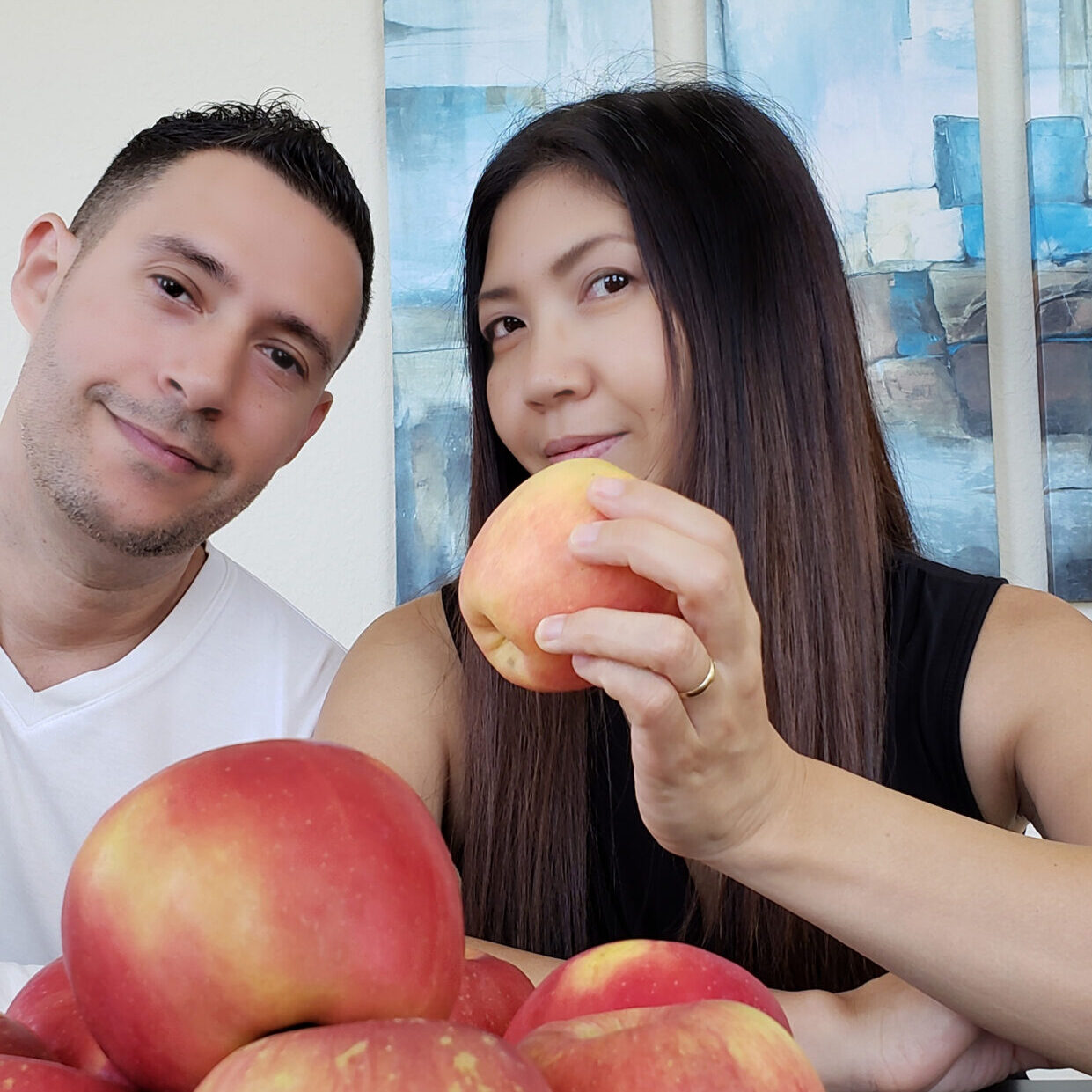Last Updated on June 26, 2022
[ぬか床]
Nukadoko (A Fermented Rice Bran Bed for Pickling) is an essential component for making quintessential Japanese pickles called Nukazuke. My Nukadoko is made from scratch with rice bran, sea salt, water, kombu and chili peppers. It’s quite a process from start to finish but once you make it, you could reuse it semi permanently with proper maintenance! It’s naturally vegan and gluten-free.
What’s Nukadoko (A Fermented Rice Bran Bed for Pickling)?
Overview
Nukadoko is basically a bed for pickling. It can be translated as Nuka [ぬか(rice bran)] + Doko [床(bed).]
The main ingredient of nukadoko is the nuka (rice bran) which is basically the outer layers of rice grain that you see on brown rice. When the rice crops are milled to make white rice, what’s left is the bran. Actually, nuka (rice bran) is high in fiber, minerals and vitamins which means it’s highly nutritious.
When you nest raw veggies in nukadoko for a couple of hours at a room temperature or 12-24 hours in the fridge, the veggies will be pickled (actual time vary depending on the climate, the condition of nukadoko and the storage method.) As a result, you will have delicious Japanese pickles called nukazuke.
Just like other fermented food, nukazuke is rich in probiotics which is something you may want to incorporate into your diet for your gut health. Not to mention, it’s vegan and there’s absolutely nothing artificial in both nukadoko (A Fermented Rice Bran Bed for Pickling) and nukazuke.
When it comes to nukadoko making, every family has their own nukadoko recipe but the commonly used basic ingredients are:
- Rice Bran
- Sea Salt
- Water
- Dried Red Hot Chili Pepper (Takanotsume)
- Dried Kombu
- Veggie Scraps (such as daikon, cabbage, carrot)
You can also use dried shiitake to increase umami level and/or sansho peppers to add a unique aroma and a hint of numbing sensation. In this nukadoko recipe, I made with the very basic ingredients above.
Once you make the nukadoko, making nukazuke is very easy to do with a few simple steps. All you have to do is to let veggies of your choice “sleep” in the nukadoko. Wash off the nukadoko mixture and it’s ready to eat!
Nukazuke
As mentioned, nukazuke is a type of Japanese fermented pickles made in nukadoko. It can be translated as Nuka [ぬか(rice bran)] + Zuke [漬け(pickling).] It’s a typical Japanese side dish that’s often served with rice.
Just like other pickles in general, nukazuke is also briny however it’s not really sour (unless you pickle for a week or so.) It has unique aroma and taste due to the fermentation of rice bran but the smell is not overly strong where it stings your nose like kimchi.
The pleasant brininess and the aroma pairs very well with a warm bowl of rice. For me, as long as I have nukazuke, all I need is rice and that can be a complete meal!
Typical choices for pickling for nukazuke are:
- Cucumber
- Daikon Radish
- Carrot
- Eggplant
- Japanese Turnip
- Napa Cabbage
- Cabbage
- Burdock Root
- Asparagus
- Paprika
- Okra
- Celery
- Nagaimo (Mountain Yam)
- Myoga (Japanese Ginger) etc.
Some unusual choices can be:
- Tofu
- Konnyaku (Konjac)
- Avocado
- Natto etc.
I haven’t tried all of them just yet, but now I have my own nukadoko, I’m so curious to explore the endless possibilities of nukazuke. As my mom said to me, “Go with your gut, if you think it’s suitable for making nukazuke, it usually works!”
But first, you won’t be able to make nukazuke without nukadoko!
Why I Made Nukadoko (A Fermented Rice Bran Bed for Pickling)
I’m not gonna lie, I was a little bit intimidated making my own nukadoko from scratch. I’ve used premade one in the past but since it was already made I had no control over the quality. If you know me, I try my best to eat as organically as possible and I really enjoy the aspect of making my own food from scratch.
After I made it, I realized it wasn’t as intimidating as I’d had imagined!
It sure takes time, consistency and some effort but the end result was beyond my expectations! On top of that, since this was a long-waited project on my to-do list, I feel very proud of myself for accomplishing it!
Update: It’s been almost a year since I made this nukadoko and I still use the same exact nukadoko to make nukazuke! Yes, it requires some ongoing maintenance and It’s a learning process but it just keeps getting better! My current nukadoko tastes more “matured” in a way.
Things to Know Before Making Nukadoko
Initial Process
The initial preparation of nukadoko (A Fermented Rice Bran Bed for Pickling) is pretty easy because you just have to mix and combine all the ingredients. I’d say the tedious part is the maintenance including the 20 days of mixing everyday and replacing veggie scraps a few times.
Maintenance
Even after finishing making the nukadoko, you still can’t just leave it there. Nukadoko needs ongoing maintenance such as mixing (every 2-3 days when refrigerated), removing liquid & adding nuka (rice bran) to adjust the consistency and more. It’s not hard to do but you really need to take care of it!
Also, as you pickle veggies, the condition of nukadoko constantly keep changing. That means you will need to remove water, add more nuka (rice bran) salt, and other ingredients to keep the stable condition according to your preference. That is also one of the routine work to maintain good nukadoko.
Storage
Nukadoko can be stored at a room temperature which is actually the traditionally way. The pros of storing at room temperature is you can pickle in a lot shorter time which can be in a few hours instead 12-24 hours in the fridge. The cons are it requires closer attentions such as mixing more often (at least once a day), it may attract bugs and mold may grow if lacking proper maintenance. Unlike the refrigeration method, bacteria in nukadoko is more active which favors the nukadoko to be more “alive” at a room temperature.
For me, I keep my nukadoko in the fridge and I haven’t had any issues and it’s pretty easy to manage with a routine maintenance.
For those reasons, making nukadoko may not be for everyone. But if you enjoy making fermented food or want to learn how to make authentic Japanese pickles, this nukadoko (A Fermented Rice Bran Bed for Pickling) recipe is a perfect project for you!
Remember, once you make it, you can use it semi permanently as long as you keep maintaining it properly! Personally, I’m so glad I did it!
Ingredients
- 2 lbs / 1 kg rice bran
- 59 oz /130 g fine sea salt
- 8 oz / 1000 ml purified water
- 2 pcs whole dried red chili peppers (preferably Takanotsume pepper [Japanese red chili peppers])
- 2 in x 4 in / 5 cm x 10 cm (5 g / 0.18 oz) dried kombu sheet, cut into 0.5 in/1.5 cm strips
- A few pieces of fresh veggie scraps, cleaned and pat dried (cabbage, napa, carrot, daikon radish would be good choices)
Instructions (Step by Step)
1. In an oversized large mixing bowl or something similar, combine rice bran and sea salt.
Use clean hand and mix until well incorporated.
2. Slowly add water (separate into 2-3 times to avoid lumps) and mix by hand until well incorporated. Squeezing the mixture with hand may be the best way to do this.
3. Transfer the rice bran mixture to a container to store nukadoko (see the “Choice of Container” in the “Notes” below.)
4. Add red chili peppers and kombu strips and mix again.
5. Place veggie scraps and bury them into the mixture completely.
Use hand to compress the mixture down to get rid of air pockets.
Wipe off the rim of the container with a clean cloth then cover lightly (crack open) and store in a cool & dry place (not in the fridge yet) and avoid direct sunlight (68-77F°/20-25 C°.)
6. For the first 10 days, mix thoroughly twice a day (every 12 hours.) For mixing, you can do by using a rice paddle, a stir fry paddle, a spatula, or by clean hand. At the time of mixing, taste a tiny amount of the rice bran mixture. This is a perfect way to check the fermentation progress. Remove the veggie scraps and replace with new ones every 4-5 days (see the complete step-by-step instructions of “How to Replace Veggie Scraps.” below as well as “A guide for Checking Fermentation Progress” in the “Notes & Tips” below.)
7. For the next 10 days, mix thoroughly once a day (every 24 hours.) Follow the same instructions in step 5 & 6. The only difference is that you can cover with the lid completely.
8. The mixture should be fully fermented around day 20. At this point, it should still taste briny but not harsh, and have richer & complex umami flavor, with a hint of sourness. Those are the signs of properly fermented nukadoko. Now, cover with the lid completely and store the container in the fridge. At the cold temperature in fridge, the mixture will be in a stable condition and slow down the process of fermentation. However, you will need to mix the mixture at least every 2-3 days or more often to avoid getting mold (see the “Ongoing Maintenance” in the “Notes & Tips” below.)
9. Now you can use it to start making nukazuke pickles!
How to Replace Veggie Scraps (Step by Step)
1. Remove the old veggie scraps from the nukadoko.
Use fingers and strip off the rice bran that’s coated around the veggies as much as possible. Do this over the container so you don’t waste any the rice bran mixture!
2. Then, squeeze the veggie scraps over the container to collect liquid from the veggies and set aside. You should taste the scraps to check the fermentation progress. After that, place new veggie scraps and bury them into the nukadoko mixture completely.
3. Use hand to compress the nukadoko mixture down to get rid of air pockets. Cover lightly (crack open) for the first 10 days and cover completely for the next 10 days. Store in a cool & dry place and avoid direct sunlight.
Tips & Notes
Choice of Container
- Use a container with a lid that’s large enough to fit a Japanese cucumber or a half of English cucumber. Also, be sure to look for something that’s easy to mix the nukadoko mixture.
- Shallow container and plastic container aren’t recommended.
- I use Noda Horo Enamel Container “Nukazuke Bijin (beauty)” that’s made for storing nukadoko. It’s an enamel coated stainless steel tub with a plastic lid. The container is a fairy small & sleek that doesn’t take up too much space in the fridge. This particular container is a perfect size for using 1 kg / 2.3 lbs of rice bran that this recipe yields for. The only thing I notice is that it isn’t air-tight so it slightly releases the smell in the fridge but it’s not bothersome. I ordered from Amazon Japan. You could also order the same one from Amazon in your country.
- If you use a different container, I suggest using a deep rectangular or round container with a lid should work (at least about 5-inch {13-cm} depth, 10-inch {24.5-cm} length.)
Measurements
- For accuracy, use a scale to measure by the weight rather than using the cup method.
- Use an equal amount of rice bran to water (1:1)
- Use 13 % of sea salt to the weight of rice bran.
Rice Bran
- Rice bran is basically the outer layers of rice grain. When the rice crops are milled to make white rice, what’s left is the bran. It’s actually high in fiber and nutritious.
- I buy Organic Rice Bran from the rice factory New York. They also have a conventional option.
- You can store the remaining rice bran in the freezer in an airtight sealed bag. You can dry roast to use them as sprinkles on rice, soup or make salad dressing!
Whole Dried Red Chili Peppers or Takanotsume Pepper
- Dried red chili peppers are to prevent the nukadoko from being spoiled.
- Since this is an authentic Japanese recipe, I use Japanese red chili peppers called takanotsume which means “the claw of the hawk.”
- If you can’t find the takanotsume pepper, other dried red chili peppers should work as long as it’s not smoked. I put them as a whole but as the days go by, they will eventually break down in the nukadoko. You can add more later as needed as a routine maintenance.
- I buy Takanotsume from The Japanese Pantry. Also, check out the takanotusme on Vegan Japanese Pantry Guide.
Dried Kombu
- Kombu is Japanese kelp which is usually sold dried.
- There are a couple of different types of dried kombu available such as ma-kombu, rausu kombu, and rishiri kombu. I’d recommend using either ma-kombu or rausu kombu for this recipe.
- I use Ma-Kombu from Japanese Pantry or Ma-Kombu from Umami Insider.
Choice of Veggie Scraps
- The veggie scraps are to start and to continue the initial fermentation.
- I say “scraps” but I don’t really mean the parts to be discarded. Make sure to use fresh & clean ones!
- It’s best to use veggies that are high in water content. I use cabbage, carrots and daikon radish. Napa cabbage can be a great choice, too!
How to Replace Veggie Scraps
- Remove the old veggie scraps from the nukadoko. Use fingers and strip off the rice bran that’s coated around the veggies as much as possible. Do this over the container so you don’t waste any the rice bran mixture!
- Then, squeeze the veggie scraps over the container to collect liquid from the veggies and set aside. You should taste the scraps to check the fermentation progress. After that, place new veggie scraps and bury them into the nukadoko mixture completely.
- Use hand to compress the nukadoko mixture down to get rid of air pockets. Cover lightly (crack open) for the first 10 days and cover completely for the next 10 days. Store in a cool & dry place and avoid direct sunlight.
A Guide for Checking Fermentation Progress
- Day 1-7: The nukadoko mixture will taste just salty and you should see the change in the consistency from being somewhat dry to slowly becoming moist.
- Around day 7-12: The nukadoko mixture will still taste salty but it gets a little milder. Instead, it slowly starts developing umami flavor.
- Around day 12-20: The nukadoko mixture will slowly start developing sourness. As the days go by, it will develop a cultured food taste like traditional cheese or other fermented food. In the end, the consistency should be similar to miso paste and the taste should be briny, richer in umami, more complex, pleasantly sour, with a cheese-like taste.
Storing Nukadoko
- Although nukadoko can be stored at a room temperature which is the traditional method, it’s more convenient to keep refrigerated for easier maintenance.
- Nukadoko doesn’t have a strong (unpleasant) smell but it certainly has a distinctive smell (kind of nutty and slightly pickled-radish-like smell.) It’s not truly a bad smell but you’ll know it’s there.
Ongoing Maintenance
- Keep the fully fermented nukadoko tub (container) in the fridge. Mix thoroughly at least once every 2-3 days to avoid getting spoiled. When mixing, remember to compress the nukadoko mixture down to get rid of air pockets, then clean the edge of the container, then put the lid back on.
- After a few days of not mixing nukadoko, you may see a white substance forming on the surface of nukadoko which is normal. Just mix it as usual.
- As you start making pickles, veggies will release moisture and the nukadoko will slowly become diluted and loose. When this happens, it’s important to maintain the proper salt level and the consistency by adding more salt and extra rice bran as needed.
- You can also replenish chili peppers and kombu as needed.
If you enjoy the recipe, please share, leave a comment below and tag us @plantbased_matters on Instagram! We appreciate your kind support 🙂
Nukadoko (A Fermented Rice Bran Bed for Pickling)
Ingredients
- 1 kg rice bran
- 130 g fine sea salt
- 1000 ml water
- 2 pcs whole dried red chili peppers preferably Takanotsume pepper [Japanese red chili peppers]
- 5 g dried kombu sheet (2 in x 4 in / 5 cm x 10 cm) cut into 0.5 in / 1.5 cm strips
- A few pieces of fresh veggie scraps cleaned and pat dried (cabbage, napa, carrot, daikon radish would be good choices)
Instructions
- In an oversized large mixing bowl or something similar, combine rice bran and sea salt. Use hand and mix until well incorporated.
- Slowly add water (separate into 2-3 times to avoid lumps) and mix by clean hand until well incorporated. Squeezing the mixture with hand may be the best way to do this.
- Transfer the rice bran mixture to a container to store nukadoko (see the “Choice of Container” in the “Notes” below.)
- Add red chili peppers and kombu strips and mix again.
- Place veggie scraps and bury them into the mixture completely. Use hand to compress the mixture down to get rid of air pockets. Wipe off the rim of the container with a clean cloth then cover lightly (crack open) and store in a cool & dry place (not in the fridge yet) and avoid direct sunlight (68-77F°/20-25 C°.)
- For the first 10 days, mix thoroughly twice a day (every 12 hours.) For mixing, you can do by using a rice paddle, a stir fry paddle, a spatula, or by clean hand. At the time of mixing, taste a tiny amount of the rice bran mixture. This is a perfect way to check the fermentation progress. Remove the veggie scraps and replace with new ones every 4-5 days (see the complete instructions of “How to Replace Veggie Scraps” and “A guide for Checking Fermentation Progress” in the “Notes” below.)
- For the next 10 days, mix thoroughly once a day (every 24 hours.) Follow the same instructions in step 5 & 6. The only difference is that you can cover with the lid completely.
- The mixture should be fully fermented around day 20. At this point, it should still taste briny but not harsh, and have richer & complex umami flavor, with a hint of sourness. Those are the signs of properly fermented nukadoko. Now, cover with the lid completely and store the container in the fridge. At the cold temperature in fridge, the mixture will be in a stable condition and slow down the process of fermentation. However, you will need to mix the mixture at least every 2-3 days or more often to avoid getting mold (see the “Ongoing Maintenance” in the “Notes” below.)
- Now you can use it to start making nukazuke pickles!
Notes
- Use a container with a lid that’s large enough to fit a Japanese cucumber or a half of English cucumber. Also, be sure to look for something that’s easy to mix the nukadoko mixture.
- Shallow container and plastic container aren’t recommended.
- I use Noda Horo Enamel Container “Nukazuke Bijin (beauty)” that’s made for storing nukadoko. It's an enamel coated stainless steel tub with a plastic lid. The container is a fairy small & sleek that doesn't take up too much space in the fridge. This particular container is a perfect size for using 1 kg / 2.3 lbs of rice bran that this recipe yields for. The only thing I notice is that it isn't air-tight so it slightly releases the smell in the fridge but it's not bothersome. I ordered from Amazon Japan. You could also order the same one from Amazon in your country.
- If you use a different container, I suggest using a deep rectangular or round container with a lid should work (at least about 5-inch {13-cm} depth, 10-inch {24.5-cm} length.)
- For accuracy, use a scale to measure by the weight rather than using the cup method.
- Use an equal amount of rice bran to water (1:1)
- Use 13 % of sea salt to the weight of rice bran.
- Rice bran is basically the outer layers of rice grain. When the rice crops are milled to make white rice, what's left is the bran. It's actually high in fiber and nutritious.
- I buy Organic Rice Bran from the rice factory New York. They also have a conventional option.
- You can store the remaining rice bran in the freezer in an airtight sealed bag. You can dry roast to use them as sprinkles on rice, soup or make salad dressing!
- Dried red chili peppers are to prevent the nukadoko from being spoiled.
- Since this is an authentic Japanese recipe, I use Japanese red chili peppers called takanotsume which means "the claw of the hawk.”
- If you can't find the takanotsume pepper, other dried red chili peppers should work as long as it's not smoked. I put them as a whole but as the days go by, they will eventually break down in the nukadoko. You can add more later as needed as a routine maintenance.
- I buy Takanotsume from The Japanese Pantry.
- Kombu is Japanese kelp which is usually sold dried.
- There are a couple of different types of dried kombu available such as ma-kombu, rausu kombu, and rishiri kombu. I’d recommend using either ma-kombu or rausu kombu for this recipe.
- I use Ma-Kombu from Japanese Pantry or Ma-Kombu from Umami Insider.
- The veggie scraps are to start and to continue the initial fermentation.
- I say "scraps" but I don't really mean the parts to be discarded. Make sure to use fresh & clean ones!
- It's best to use veggies that are high in water content. I use cabbage, carrots and daikon radish. Napa cabbage can be a great choice, too!
- Remove the old veggie scraps from the nukadoko. Use fingers and strip off the rice bran that’s coated around the veggies as much as possible. Do this over the container so you don’t waste any the rice bran mixture!
- Then, squeeze the veggie scraps over the container to collect liquid from the veggies and set aside. You should taste the scraps to check the fermentation progress. After that, place new veggie scraps and bury them into the nukadoko mixture completely.
- Use hand to compress the nukadoko mixture down to get rid of air pockets. Cover lightly (crack open) for the first 10 days and cover completely for the next 10 days. Store in a cool & dry place and avoid direct sunlight.
- Day 1-7: The nukadoko mixture will taste just salty and you should see the change in the consistency from being somewhat dry to slowly becoming moist.
- Around day 7-12: The nukadoko mixture will still taste salty but it gets a little milder. Instead, it slowly starts developing umami flavor.
- Around day 12-20: The nukadoko mixture will slowly start developing sourness. As the days go by, it will develop a cultured food taste like traditional cheese or other fermented food. In the end, the consistency should be similar to miso paste and the taste should be briny, richer in umami, more complex, pleasantly sour, with a cheese-like taste.
- Although nukadoko can be stored at a room temperature which is the traditional method, it’s more convenient to keep refrigerated for easier maintenance.
- Nukadoko doesn't have a strong (unpleasant) smell but it certainly has a distinctive smell (kind of nutty and slightly pickled-radish-like smell.) It's not truly a bad smell but you'll know it's there.
- Keep the fully fermented nukadoko tub (container) in the fridge. Mix thoroughly at least once every 2-3 days to avoid getting spoiled. When mixing, remember to compress the nukadoko mixture down to get rid of air pockets, then clean the edge of the container, then put the lid back on.
- After a few days of not mixing nukadoko, you may see a white substance forming on the surface of nukadoko which is normal. Just mix it as usual.
- As you start making pickles, veggies will release moisture and the nukadoko will slowly become diluted and loose. When this happens, it’s important to maintain the proper salt level and the consistency by adding more salt and extra rice bran as needed.
- You can also replenish chili peppers and kombu as needed.
